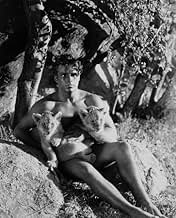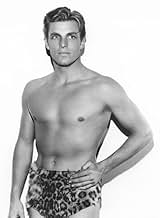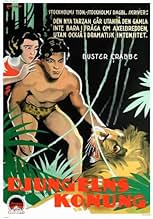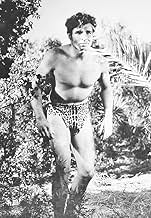अपनी भाषा में प्लॉट जोड़ेंA white youth who is raised in the jungle by the animals is captured by a safari and brought back to civilization as an attraction in a circus.A white youth who is raised in the jungle by the animals is captured by a safari and brought back to civilization as an attraction in a circus.A white youth who is raised in the jungle by the animals is captured by a safari and brought back to civilization as an attraction in a circus.
Douglass Dumbrille
- Ed Peters
- (as Douglas Dumbrille)
Ronnie Cosby
- Kaspa at age three
- (as Ronnie Cosbey)
Robert Adair
- John C. Knolls
- (बिना क्रेडिट के)
Florence Britton
- Mrs. Edith Knolls
- (बिना क्रेडिट के)
Don Brodie
- Reporter
- (बिना क्रेडिट के)
Leonard Carey
- Clerk at Hunting License Bureau
- (बिना क्रेडिट के)
Nora Cecil
- Spinster in Park
- (बिना क्रेडिट के)
फ़ीचर्ड समीक्षाएं
Jumping on the bandwagon in Hollywood can produce almost guaranteed profits at the box office. When 1932's "Tarzan The Ape Man" with Johnny Weissmuller became such a huge hit, Paramount Pictures began looking for a similarly-themed vehicle to hitch its wagon. The studio found it in the form of Buster Crabbe in March 1933's "King of the Jungle." Paramount researchers found a book resembling Edgar Rice Burroughs' Tarzan series in Charles Thurley Stoneham's 1931 'The Lion's Way,' about a boy whose parents get killed on a Kenyan trip and is raised by lions. Paramount copied Tarzan's recruitment process by scouting for a potential lead actor by looking at the athletes competing in the nearby Los Angles 1932 Olympic Games. Canvasing forty competitors at the games, Paramount executives chose one after a series of screen tests: Clarence Linden Crabbe..
Crabbe's role as Kaspa the Lion Man in "King of the Jungle" began an 180 film and television show career that lasted through the early 1980s. He was especially popular in a number of film series, earning the moniker "King of Serials," playing such famous characters as Flash Gordon, Buck Rogers, Billy the Kid, and even Tarzan himself. Going by his nickname Buster, Crabbe was humbled about his acting talent. "Some say, that my acting rose to the point of incompetence and then leveled off," he said in retrospect.
He remembered auditioning for the Kaspa part. "Just before the Olympics we went down to be tested," Crabbe said. "They had us all throw a spear and pick up a paper-mache rock. About three days after the Olympics they called me back. I finally got the part." Crabbe, who grew up in Hawaii and attended the University of Southern California, excelled in swimming, earning the bronze medal in the 1928 Summer Olympics in Amsterdam, the same games where Johnny Weismuller, the first talking Tarzen on the screen, won two gold medals in swimming. In the 1932 games, Crabbe won the gold in the 400 meters freestyle by one-tenth of a second. "That one-tenth of a second changed my life," recalled Crabbe. "It was then the Hollywood scouts discovered latent histrionic abilities in me." What differentiated "King of the Jungle" to "Tarzan the Ape Man" was Crabbe's character, the African-raised Kaspa, ends up spending most of his time in the United States after his capture by two white game hunters, who sell him to an American promoter. Kaspa isn't the animal fighter that Tarzan was. Just before arriving on the United States shores to be a showman messing around with lions, he escapes. Kaspa meets his 'Jane," Ann Rogers (Frances Dee), when he climbs through an apartment window to steal her and her roommates' food on the dinner table while clothed just in his loin cloth. Ann gets friendly with Kaspa and teaches him English. She has to start from Ground Zero to show him some lessons in civilized conduct before he's hired as a circus lion tamer. His job sets up the exciting conclusion where a spectacular fire runs throughout the circus tents, threatening his best friends, the lions.
Crabbe's competent acting and strong physic, one he maintained throughout his early 70s by swimming two miles a day partly to alleviate his arthritis, assured the actor a busy and rewarding acting career. Late in life, Crabbe, half-kidding, said he made only one A-movie and the "rest falling at least one letter lower in the alphabet."
Crabbe's role as Kaspa the Lion Man in "King of the Jungle" began an 180 film and television show career that lasted through the early 1980s. He was especially popular in a number of film series, earning the moniker "King of Serials," playing such famous characters as Flash Gordon, Buck Rogers, Billy the Kid, and even Tarzan himself. Going by his nickname Buster, Crabbe was humbled about his acting talent. "Some say, that my acting rose to the point of incompetence and then leveled off," he said in retrospect.
He remembered auditioning for the Kaspa part. "Just before the Olympics we went down to be tested," Crabbe said. "They had us all throw a spear and pick up a paper-mache rock. About three days after the Olympics they called me back. I finally got the part." Crabbe, who grew up in Hawaii and attended the University of Southern California, excelled in swimming, earning the bronze medal in the 1928 Summer Olympics in Amsterdam, the same games where Johnny Weismuller, the first talking Tarzen on the screen, won two gold medals in swimming. In the 1932 games, Crabbe won the gold in the 400 meters freestyle by one-tenth of a second. "That one-tenth of a second changed my life," recalled Crabbe. "It was then the Hollywood scouts discovered latent histrionic abilities in me." What differentiated "King of the Jungle" to "Tarzan the Ape Man" was Crabbe's character, the African-raised Kaspa, ends up spending most of his time in the United States after his capture by two white game hunters, who sell him to an American promoter. Kaspa isn't the animal fighter that Tarzan was. Just before arriving on the United States shores to be a showman messing around with lions, he escapes. Kaspa meets his 'Jane," Ann Rogers (Frances Dee), when he climbs through an apartment window to steal her and her roommates' food on the dinner table while clothed just in his loin cloth. Ann gets friendly with Kaspa and teaches him English. She has to start from Ground Zero to show him some lessons in civilized conduct before he's hired as a circus lion tamer. His job sets up the exciting conclusion where a spectacular fire runs throughout the circus tents, threatening his best friends, the lions.
Crabbe's competent acting and strong physic, one he maintained throughout his early 70s by swimming two miles a day partly to alleviate his arthritis, assured the actor a busy and rewarding acting career. Late in life, Crabbe, half-kidding, said he made only one A-movie and the "rest falling at least one letter lower in the alphabet."
KING OF THE JUNGLE (Paramount, 1933), directed by H. Bruce Humberstone, from Charles T. Stoneham's novel, "The Lion's Way," is an adventure story that capitalizes on the current success of TARZAN, THE APE MAN (MGM, 1932), that starred Olympic swimming champion Johnny Weissmuller. While it's quite evident for rival studios to come up with imitations of their own, this appears to have been the only one made during the height of all those "Tarzan" adventures and the long series of popular sequels and carbon copies. Paramount acquired its own Olympic swimming champion in the physique of Larry "Buster" Crabbe, much taller and broader shoulders than Weissmuller, in a Tarzan-like imitation as Kaspa, the Lion Man, but unlike "Tarzan," this one didn't develop into a "Kaspa" series in spite of it's somewhat left open conclusion.
The story opens in the jungles of Africa where coming down a hill is a little boy (Ronnie Cosbey) in safari clothes roaming about by himself. He encounters little lion cubs, starts playing with them until the mother lion approaches. She carries the boy away, but eventually allows the youngster to continue to play with her cubs. This epilogue fades some twenty years showing the development of this little straight haired blond boy into a grown-up curly darker-haired jungle man sporting a leopard skin loincloth, roaming about the jungle helping his lion friends. Enter the white hunters who encounter this half-naked native who only communicates in grunts and groans. He's captured and caged up labeled as "what is it?" in a cargo ship bound for America along with the lions, where he is to be sold off as a circus attraction. However, close to port, Kaspa escapes his captivity, swims towards the city where he is soon noticed by spinster passersby taking a stroll through the park one day. They notify the police that they have spotted a naked man in the area. Pursued by the police, Kaspa enters into an open window to the apartment of Anne Rogers (Frances Dee), a schoolteacher, and her roommate, Sue (Nydia Westman). After offering him some food and seeing he could be tamed, especially since he's captivated by her beauty, Anne, after encountering Kaspa's captures, agrees to assume her new position in educating and civilizing the jungle man while becoming part of a lion act at the circus. In spite of his fame and fortune, Kaspa finds he's not happy with his new life and wants to return to Africa, taking the lions with him, but is faced with certain situations holding him back.
In watching KING OF THE JUNGLE, one cannot help but compare this to the Edgar Rice Burroughs character. Unlike the "Tarzan" adventures, KING OF THE JUNGLE takes a different turn in not being set entirely in the jungle. It does consist of some wildlife scenes in the beginning, but nothing memorable nor climatic as those frequent crocodiles fights or native uprising in the Tarzan tradition. During its second half which finds Kaspa in civilization, he is taught to read, write and speak in an articulate manner by his teacher girlfriend (not like the MGM series where Tarzan speaks only in mono syllables), as well as abandon his jungle attire while off duty from the circus to go seen fully clothed, predating Weissmuller's trip to the Big Apple by nine years in TARZAN'S NEW YORK ADVENTURE (1942) which has Tarzan in Stone Jungle wearing fashionable suits. However, much of the true action in KING OF THE JUNGLE takes place in the circus portion highlighted by a fire blaze where Kaspa risks his life to save his caged animal friends, especially the lions.
Although a good story, there's really no explanation to Kaspa's origins, who his people are, and why and how he, as a little boy of 3, ended up in the jungle of cubs in the first place. Could it be that there was an airplane crash, for instance, by which the youngster became the lone survivor? How did he acquire the name of Kaspa? Did scenes such as the aforementioned wind up on the cutting room floor before its theatrical release?
Aside from Frances Dee as Kaspa's newfound mate, Sidney Toler as the circus owner, Irving Pichel and Douglass Dumbrille add fine support, along with Warner Richmond Barrat as the drunken circus worker responsible for the fire, and Patricia Farley as a circus employee/ flirt who has her her eyes on Kaspa, only to be told by the educated jungle man in his new English vocabulary to "Scram!" as she tries to get his attention.
In the mid 1970s, aside from seeing this movie occasionally on commercial TV, I recall watching "Buster" Crabbe as guest on the long running "Joe Franklin Show," based in New York City on WOR, Channel 9, where he recalled KING OF THE JUNGLE to be the only "A" movie he ever made. Although Crabbe did lose out in playing Tarzan to Weissmuller a year before, he did enact the part in an independent chaptered serial and re-edited feature of TARZAN THE FEARLESS (1933). Much to the delight of Weissmuller fans, Crabbe never played the legendary jungle hero again. Two Tarzans, too many. However, Crabbe did leave a mark in cinema history playing "Flash Gordon" and "Buck Rogers" for Universal's weekly serial department.
Out of circulation since it's frequent showings on American Movie Classics in 1989, KING OF THE JUNGLE, which runs at 70 minutes, is currently available on video by logging onto TVIDEO.com (***)
The story opens in the jungles of Africa where coming down a hill is a little boy (Ronnie Cosbey) in safari clothes roaming about by himself. He encounters little lion cubs, starts playing with them until the mother lion approaches. She carries the boy away, but eventually allows the youngster to continue to play with her cubs. This epilogue fades some twenty years showing the development of this little straight haired blond boy into a grown-up curly darker-haired jungle man sporting a leopard skin loincloth, roaming about the jungle helping his lion friends. Enter the white hunters who encounter this half-naked native who only communicates in grunts and groans. He's captured and caged up labeled as "what is it?" in a cargo ship bound for America along with the lions, where he is to be sold off as a circus attraction. However, close to port, Kaspa escapes his captivity, swims towards the city where he is soon noticed by spinster passersby taking a stroll through the park one day. They notify the police that they have spotted a naked man in the area. Pursued by the police, Kaspa enters into an open window to the apartment of Anne Rogers (Frances Dee), a schoolteacher, and her roommate, Sue (Nydia Westman). After offering him some food and seeing he could be tamed, especially since he's captivated by her beauty, Anne, after encountering Kaspa's captures, agrees to assume her new position in educating and civilizing the jungle man while becoming part of a lion act at the circus. In spite of his fame and fortune, Kaspa finds he's not happy with his new life and wants to return to Africa, taking the lions with him, but is faced with certain situations holding him back.
In watching KING OF THE JUNGLE, one cannot help but compare this to the Edgar Rice Burroughs character. Unlike the "Tarzan" adventures, KING OF THE JUNGLE takes a different turn in not being set entirely in the jungle. It does consist of some wildlife scenes in the beginning, but nothing memorable nor climatic as those frequent crocodiles fights or native uprising in the Tarzan tradition. During its second half which finds Kaspa in civilization, he is taught to read, write and speak in an articulate manner by his teacher girlfriend (not like the MGM series where Tarzan speaks only in mono syllables), as well as abandon his jungle attire while off duty from the circus to go seen fully clothed, predating Weissmuller's trip to the Big Apple by nine years in TARZAN'S NEW YORK ADVENTURE (1942) which has Tarzan in Stone Jungle wearing fashionable suits. However, much of the true action in KING OF THE JUNGLE takes place in the circus portion highlighted by a fire blaze where Kaspa risks his life to save his caged animal friends, especially the lions.
Although a good story, there's really no explanation to Kaspa's origins, who his people are, and why and how he, as a little boy of 3, ended up in the jungle of cubs in the first place. Could it be that there was an airplane crash, for instance, by which the youngster became the lone survivor? How did he acquire the name of Kaspa? Did scenes such as the aforementioned wind up on the cutting room floor before its theatrical release?
Aside from Frances Dee as Kaspa's newfound mate, Sidney Toler as the circus owner, Irving Pichel and Douglass Dumbrille add fine support, along with Warner Richmond Barrat as the drunken circus worker responsible for the fire, and Patricia Farley as a circus employee/ flirt who has her her eyes on Kaspa, only to be told by the educated jungle man in his new English vocabulary to "Scram!" as she tries to get his attention.
In the mid 1970s, aside from seeing this movie occasionally on commercial TV, I recall watching "Buster" Crabbe as guest on the long running "Joe Franklin Show," based in New York City on WOR, Channel 9, where he recalled KING OF THE JUNGLE to be the only "A" movie he ever made. Although Crabbe did lose out in playing Tarzan to Weissmuller a year before, he did enact the part in an independent chaptered serial and re-edited feature of TARZAN THE FEARLESS (1933). Much to the delight of Weissmuller fans, Crabbe never played the legendary jungle hero again. Two Tarzans, too many. However, Crabbe did leave a mark in cinema history playing "Flash Gordon" and "Buck Rogers" for Universal's weekly serial department.
Out of circulation since it's frequent showings on American Movie Classics in 1989, KING OF THE JUNGLE, which runs at 70 minutes, is currently available on video by logging onto TVIDEO.com (***)
No, this is not a Tarzan film; the name of the hero here is Kaspa (and it is not a ghost movie, either). Kaspa was raised by lions and trapped by white bwanas to be taken back to New York (like King Kong). Some of the scenes are quite remarkable; especially ones with the young child Kaspa in the beginning of the film. However, the film could not possibly have the disclaimer that no animals were hurt or killed in the filming of this movie. Other than that unpleasant caveat, the film is immensely entertaining and good fun for the whole family.
Paramount's answer to Tarzan, with Olympic athlete Buster Crabbe as a child raised to adulthood by a pride of lions. The expected complications result when Buster and his furry pals are transported to a circus. Charmingly clumsy in its early scenes, the film builds to an exciting, fiery conclusion. Animal activists will wince at a brutal battle between some big cats, but otherwise it's very entertaining.
This 1933 pre-code antique is a delight on several levels. For once, it's a jungle movie from the early thirties when MGM's Johnny Weismuller was bringing in the money as that studio's Tarzan. So, Paramount wanted some of the jungle action and created this very enjoyable variation of the wild boy raised in the jungle by wild animals.
I've always felt Buster Crabbe was terribly under-rated. Here he is in all his near naked glory as Kaspa, the Lion King. We're never really explained as to how he escaped a wrecked plane and managed to grow up into this radiant Adonis but since this movie was made before the production code, we get to see lots of Buster since he wears a bikini sling-shot so abbreviated that he really is virtually naked, except for his rear-end. In fact, the movie's ads were aimed primarily at the women audience members at their chance to see a beautiful Adonis in the near altogether as this jungle god.
The cast is surprisingly strong with excellent production values, camera work and editing. The best part of the movie by far is the huge circus fire at the end. Not sure how they did this but the fleeing circus patrons look genuinely terrified and Buster is in his glory as he breaks through the police lines to rescue his beloved cats.
There is naturally a love story to all this and Francis Dee makes a delightful choice as a school teacher who see's the real potential of this jungle boy when he invades her apartment. She takes him under her wing and travels with the circus to support and educate him.
This was Buster's first movie, fresh from winning major swimming olympic awards and his natural beauty is spell-bounding. His torso is beautifully proportioned, he sports a thick head of dark curls and his face is as innocent and boyish as one would expect of a young male suddenly thrust from the jungle into the wilds of a big city.
This quality of wide-eyed innocence is what new audiences are discovering about Buster Crabbe as they watch him in "Flash Gordon", his various serials and especially another jungle yarn, "Tarzan the Fearless" in which he reprises his identical bikini slingshot and makes a very appealing young Tarzan.
क्या आपको पता है
- ट्रिवियाBuster Crabbe narrowly lost the role of Tarzan to Johnny Weissmuller, so he starred in this Tarzan "copycat" film.
- गूफ़Biggest plot hole is that a human being can not be bought and sold else it is human trafficking, illegal under international law. Also he could not enter or leave any country without a passport.
- कनेक्शनEdited into Caged Fury (1948)
टॉप पसंद
रेटिंग देने के लिए साइन-इन करें और वैयक्तिकृत सुझावों के लिए वॉचलिस्ट करें
विवरण
- चलने की अवधि1 घंटा 13 मिनट
- रंग
- पक्ष अनुपात
- 1.37 : 1
इस पेज में योगदान दें
किसी बदलाव का सुझाव दें या अनुपलब्ध कॉन्टेंट जोड़ें




































